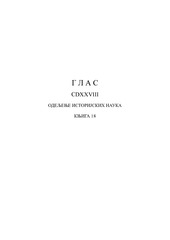Приказ основних података о документу
Српска православна црквеношколска општина у Мостару
Serbian Orthodox church-educational municipality in Mostar
| dc.creator | Радосављевић, Недељко В. | |
| dc.date.accessioned | 2020-09-09T13:25:57Z | |
| dc.date.available | 2021-01-01 | |
| dc.date.issued | 2018 | |
| dc.identifier.issn | 0351-4765 | |
| dc.identifier.uri | https://dais.sanu.ac.rs/123456789/9103 | |
| dc.description.abstract | The Serbian Orthodox Church-Educational Municipality in Mostar is one of the oldest and most eminent in the areas inhabited by the Serbian population of Orthodox faith. Its particularity is reflected primarily in the wide autonomy that it enjoyed compared to higher spiritual authorities, most notably the metropolitans of Herzegovina. The Mostar Church Municipality, as it was called at the beginning, was created upon the model of the older Sarajevo Municipality. However, while the Sarajevo Municipality was created gradually, by means of a number of acts of metropolitans of Dabar-Bosnia, the Mostar Municipality was created by means of a single act – the Decree, adopted by Metropolitan Josif in 1835. Its autonomy, wide for Serbian circumstances of the time, was established during the Ali-pasha Rizvanbegović’s despotic rule of the Pashaluk of Herzegovina, which indicates the degree to which, at such time as well, the Orthodox inhabitants of Mostar were apt to realise such an important goal. From its formation, the Municipality also dealt with educational issues. In time, after the introduction of systemic education in the 1850s, it grew into a church-educational institution as it also cared about the construction and maintenance of schools, enrolment of children and payment of teachers. Owing to the Municipality, Mostar also received a female school. The Theological School was active in Mostar for some time as well. The Municipality selected and the metropolitan endorsed priests. It independently disposed of revenue and material goods. Builders and stone-cutters were also selected by the Municipality. The attempts of some metropolitans, such as Avksentije III Petrov Češmedžijev, to diminish the Municipality’s autonomy, were unsuccessful. The majority of metropolitans complied with the Degree and had good cooperation with the Municipality. From 1863 to 1873, owing to efforts of the Municipality’s members, the new Cathedral Church was built in Mostar. Judging by its beauty and dimensions, it was unparalleled in the areas of the Ottoman Empire inhabited by the Serbian people. The Serbian Herzegovina uprising of 1875 hampered the further development of the Municipality and spreading of its activity. Upon the Austro-Hungarian occupation of Bosnia and Herzegovina in 1878, it found itself in much different circumstances, its autonomy was reduced and even its survival was jeopardised for some time. | en |
| dc.language.iso | sr | sr |
| dc.publisher | Београд : Српска академија наука и уметности | sr |
| dc.relation | info:eu-repo/grantAgreement/MESTD/Basic Research (BR or ON)/177031/RS// | |
| dc.rights | embargoedAccess | sr |
| dc.rights.uri | https://creativecommons.org/licenses/by-nc-nd/4.0/ | |
| dc.source | Глас САНУ | sr |
| dc.subject | Mostar | sr |
| dc.subject | Church Municipality | sr |
| dc.subject | Orthodox Church | sr |
| dc.subject | educational issues | sr |
| dc.title | Српска православна црквеношколска општина у Мостару | sr |
| dc.title | Serbian Orthodox church-educational municipality in Mostar | en |
| dc.type | article | sr |
| dc.rights.license | BY-NC-ND | sr |
| dcterms.abstract | Radosavljević, Nedeljko V.; Srpska pravoslavna crkvenoškolska opština u Mostaru; | |
| dc.citation.spage | 329 | |
| dc.citation.epage | 350 | |
| dc.citation.volume | 428 | |
| dc.description.other | Глас / Српска академија наука и уметности ; 428. Одељење историјских наука ; књ.18 | sr |
| dc.identifier.cobiss | 1548087786 | |
| dc.type.version | publishedVersion | sr |
| dc.identifier.fulltext | https://dais.sanu.ac.rs/bitstream/id/38594/bitstream_38594.pdf | |
| dc.identifier.rcub | https://hdl.handle.net/21.15107/rcub_dais_9103 |

